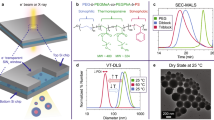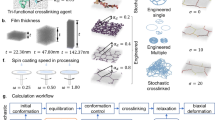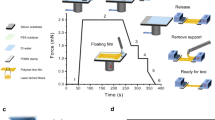Abstract
Confinement alters polymer dynamics and results in a marked Tg confinement effect, i.e., a reduction in the glass-transition temperature (Tg) of a polymer under confinement. The Tg confinement effect is related to dynamic enhancement at the air interface caused by reductions in intermolecular cohesion forces at the interface. Thus, tuning molecular interactions at the interface allows modification of the Tg confinement effects of polymers. In this work, using interfacial-sensitive sum-frequency generation (SFG) spectroscopy, we demonstrated that incorporation of bulky and polar maleic anhydride (MA) into polystyrene (PSt) chains in an alternating manner, forming an alternating copolymer of P(St-alt-MA), led to reductions in π-π and dipolar interactions at the air interface relative to those in the bulk. This reduction in molecular interactions led to greater mobility enhancement at the interface compared with the sluggish dynamics in the bulk, and accordingly, the P(St-alt-MA) alternating copolymer experienced a distinctly greater Tg confinement effect. These results demonstrated the impacts of local conformations and molecular interactions at the interface on the confinement effects of polymers and reinforced the idea of effective manipulation of confined polymer dynamics by changing the packing of molecules and functional groups at the interface.
This is a preview of subscription content, access via your institution
Access options
Subscribe to this journal
Receive 12 print issues and online access
$259.00 per year
only $21.58 per issue
Buy this article
- Purchase on Springer Link
- Instant access to full article PDF
Prices may be subject to local taxes which are calculated during checkout






Similar content being viewed by others
References
Alcoutlabi M, McKenna GB. Effects of confinement on material behaviour at the nanometre size scale. J Phys Condens Matter. 2005;17:R461–R524.
Ediger MD, Forrest JA. Dynamics near free surfaces and the glass transition in thin polymer films: a view to the future. Macromolecules. 2014;47:471–8.
Napolitano S, Glynos E, Tito NB. Glass transition of polymers in bulk, confined geometries, and near interfaces. Rep. Prog Phys. 2017;80:036602.
Richert R. Dynamics of nanoconfined supercooled liquids. Annu Rev Phys Chem. 2011;62:65–84.
Li B, Zhang S, Andre JS, Chen Z. Relaxation behavior of polymer thin films: effects of free surface, buried interface, and geometrical confinement. Prog Polym Sci. 2021;120:101431.
Jackson CL, McKenna GB. The glass transition of organic liquids confined to small pores. J Non Cryst Solids. 1991;131-133:221–4.
Keddie JL, Jones RA, Cory R. Size-dependent depression of the glass transition temperature in polymer films. Europhys Lett. 1994;27:59.
Yang Z, Fujii Y, Lee FK, Lam C-H, Tsui OK. Glass transition dynamics and surface layer mobility in unentangled polystyrene films. Science. 2010;328:1676–9.
Priestley RD, Ellison CJ, Broadbelt LJ, Torkelson JM. Structural relaxation of polymer glasses at surfaces, interfaces, and in between. Science. 2005;309:456–9.
Ellison CJ, Torkelson JM. The distribution of glass-transition temperatures in nanoscopically confined glass formers. Nat Mater. 2003;2:695–700.
Zuo B, Zhou H, Davis MJ, Wang X, Priestley RD. Effect of local chain conformation in adsorbed nanolayers on confined polymer molecular mobility. Phys Rev Lett. 2019;122:217801.
Zuo B, Li C, Xu Q, Randazzo K, Jiang N, Wang X, et al. Ultrastable glassy polymer films with an ultradense brush morphology. ACS Nano. 2021;15:9568–76.
Xu Q, Zhu N, Fang H, Wang X, Priestley RD, Zuo B. Decoupling role of film thickness and interfacial effect on polymer thin film dynamics. ACS Macro Lett. 2020;10:1–8.
Sha Y, Li L, Wang X, Wan Y, Yu J, Xue G, et al. Growth of polymer nanorods with different core–shell dynamics via capillary force in nanopores. Macromolecules. 2014;47:8722–8.
Wei W, Feng S, Zhou Q, Liang H, Long Y, Wu Q, et al. Study on glass transition and physical aging of polystyrene nanowires by differential scanning calorimetry. J Polym Res. 2017;24:1–11.
Nakanishi S, Yoshikawa H, Shoji S, Sekkat Z, Kawata S. Size dependence of transition temperature in polymer nanowires. J Phys Chem B. 2008;112:3586–9.
Wang H, Chang T, Li X, Zhang W, Hu Z, Jonas AM. Scaled down glass transition temperature in confined polymer nanofibers. Nanoscale. 2016;8:14950–5.
Zhang C, Guo Y, Priestley RD. Glass transition temperature of polymer nanoparticles under soft and hard confinement. Macromolecules. 2011;44:4001–6.
Feng S, Li Z, Liu R, Mai B, Wu Q, Liang G, et al. Glass transition of polystyrene nanospheres under different confined environments in aqueous dispersions. Soft Matter. 2013;9:4614–20.
Liu S, Lv M, Li H, Wang S, Feng C, Wang X, et al. Optical imaging of the molecular mobility of single polystyrene nanospheres. J Am Chem Soc. 2022;144:1267–73.
Zhang C, Guo Y, Shepard KB, Priestley RD. Fragility of an isochorically confined polymer glass. J Phys Chem Lett. 2013;4:431–6.
Ren W, Wang Y, Chen X, Zuo B, Zhou X, Wang X. Segmental relaxation dynamics of the core and corona in a single dry micelle. Macromolecules. 2018;51:195–203.
Mundra MK, Donthu SK, Dravid VP, Torkelson JM. Effect of spatial confinement on the glass-transition temperature of patterned polymer nanostructures. Nano Lett. 2007;7:713–8.
Robertson C, Hogan T, Rackaitis M, Puskas J, Wang X. Effect of nanoscale confinement on glass transition of polystyrene domains from self-assembly of block copolymers. J Chem Phys. 2010;132:104904.
Bansal A, Yang H, Li C, Cho K, Benicewicz BC, Kumar SK, et al. Quantitative equivalence between polymer nanocomposites and thin polymer films. Nat Mater. 2005;4:693–8.
Srivastava S, Basu J. Experimental evidence for a new parameter to control the glass transition of confined polymers. Phys Rev Lett. 2007;98:165701.
Wei T, Torkelson JM. Molecular weight dependence of the glass transition temperature (Tg)-confinement effect in well-dispersed poly (2-vinyl pyridine)–silica nanocomposites: Comparison of interfacial layer t g and matrix t g. Macromolecules. 2020;53:8725–36.
Rittigstein P, Torkelson JM. Polymer–nanoparticle interfacial interactions in polymer nanocomposites: Confinement effects on glass transition temperature and suppression of physical aging. J Polym Sci B Polym Phys. 2006;44:2935–43.
Holt AP, Bocharova V, Cheng S, Kisliuk AM, White BT, Saito T, et al. Controlling interfacial dynamics: Covalent bonding versus physical adsorption in polymer nanocomposites. ACS Nano. 2016;10:6843–52.
Mattsson J, Forrest J, Börjesson L. Quantifying glass transition behavior in ultrathin free-standing polymer films. Phys Rev E. 2000;62:5187.
Dalnoki-Veress K, Forrest J, Murray C, Gigault C, Dutcher J. Molecular weight dependence of reductions in the glass transition temperature of thin, freely standing polymer films. Phys Rev E. 2001;63:031801.
Pye JE, Roth CB. Two simultaneous mechanisms causing glass transition temperature reductions in high molecular weight freestanding polymer films as measured by transmission ellipsometry. Phys Rev Lett. 2011;107:235701.
Ma M, Guo Y. Physical properties of polymers under soft and hard nanoconfinement: a review. Chin J Polym Sci. 2020;38:565–78.
Sharp J, Forrest J. Free surfaces cause reductions in the glass transition temperature of thin polystyrene films. Phys Rev Lett. 2003;91:235701.
Yang H, Sharp JS. Interfacial effects and the glass transition in ultrathin films of poly (tert-butyl methacrylate). Macromolecules. 2008;41:4811–6.
Zuo B, Liu Y, Liang Y, Kawaguchi D, Tanaka K, Wang X. Glass transition behavior in thin polymer films covered with a surface crystalline layer. Macromolecules. 2017;50:2061–8.
Zha H, Wang Q, Wang X, Cangialosi D, Zuo B. Enhanced free surface mobility facilitates the release of free-volume holes in thin-film polymer glasses. Macromolecules. 2021;54:2022–8.
Chen L, Torkelson JM. Tuning the Tg-confinement effect in thin polymer films via minute levels of residual surfactant which “cap” the free surface. Polymer. 2016;87:226–35.
Bäumchen O, McGraw JD, Forrest JA, Dalnoki-Veress K. Reduced glass transition temperatures in thin polymer films: Surface effect or artifact? Phys Rev Lett. 2012;109:055701.
Hao Z, Ghanekarade A, Zhu N, Randazzo K, Kawaguchi D, Tanaka K, et al. Mobility gradients yield rubbery surfaces on top of polymer glasses. Nature. 2021;596:372–6.
Tian H, Xu Q, Zhang H, Priestley RD, Zuo B. Surface dynamics of glasses. Appl Phys Rev. 2022;9:011316.
Chai Y, Salez T, McGraw JD, Benzaquen M, Dalnoki-Veress K, Raphaël E, et al. A direct quantitative measure of surface mobility in a glassy polymer. Science. 2014;343:994–9.
Fakhraai Z, Forrest J. Measuring the surface dynamics of glassy polymers. Science. 2008;319:600–4.
Paeng K, Swallen SF, Ediger M. Direct measurement of molecular motion in freestanding polystyrene thin films. J Am Chem Soc. 2011;133:8444–7.
Ghanekarade A, Phan AD, Schweizer KS, Simmons DS. Nature of dynamic gradients, glass formation, and collective effects in ultrathin freestanding films. Proc Natl Acad Sci USA. 2021;118:1–8.
Pye JE, Rohald KA, Baker EA, Roth CB. Physical aging in ultrathin polystyrene films: evidence of a gradient in dynamics at the free surface and its connection to the glass transition temperature reductions. Macromolecules. 2010;43:8296–303.
Flier BM, Baier MC, Huber J, Müllen K, Mecking S, Zumbusch A, et al. Heterogeneous diffusion in thin polymer films as observed by high-temperature single-molecule fluorescence microscopy. J Am Chem Soc. 2012;134:480–8.
Zuo B, Liu Y, Wang L, Zhu Y, Wang Y, Wang X. Depth profile of the segmental dynamics at a poly (methyl methacrylate) film surface. Soft Matter. 2013;9:9376–84.
Ogieglo W, Tempelman K, Napolitano S, Benes NE. Evidence of a transition layer between the free surface and the bulk. J Phys Chem Lett. 2018;9:1195–9.
Forrest JA, Mattsson J. Reductions of the glass transition temperature in thin polymer films: Probing the length scale of cooperative dynamics. Phys Rev E. 2000;61:R53.
Kawana S, Jones R. Effect of physical ageing in thin glassy polymer films. Eur Phys J E. 2003;10:223–30.
Kawana S, Jones RA. Character of the glass transition in thin supported polymer films. Phys Rev E. 2001;63:021501.
Jin K, Torkelson JM. Enhanced Tg-confinement effect in cross-linked polystyrene compared to its linear precursor: Roles of fragility and chain architecture. Macromolecules. 2016;49:5092–103.
Evans CM, Deng H, Jager WF, Torkelson JM. Fragility is a key parameter in determining the magnitude of t g-confinement effects in polymer films. Macromolecules. 2013;46:6091–103.
Hsu DD, Xia W, Song J, Keten S. Glass-transition and side-chain dynamics in thin films: Explaining dissimilar free surface effects for polystyrene vs poly (methyl methacrylate). ACS Macro Lett. 2016;5:481–6.
Ngai K, Jonscher A, White C. On the origin of the universal dielectric response in condensed matter. Nature. 1979;277:185–9.
Ngai K, Rendell R. Explanation of mechanical and electrical relaxation due to mobile ions in a superionic glass over the range 1 Hz–20 GHz by the coupling theory. Phys Rev E. 1988;38:9987.
Ngai K, Rajagopal A, Teitler SD. Slowing down of relaxation in a complex system by constraint dynamics. J Chem Phys. 1988;88:5086–94.
Ngai K, Capaccioli S, Cao C, Bai H, Wang W. Quantitative explanation of the enhancement of surface mobility of the metallic glass Pd40Cu30Ni10P20 by the coupling model. J Non Cryst Solids. 2017;463:85–89.
Shen YR. Surface properties probed by second-harmonic and sum-frequency generation. Nature. 1989;337:519–25.
Gautam KS, Schwab AD, Dhinojwala A, Zhang D, Dougal SM, Yeganeh MS. Molecular structure of polystyrene at air/polymer and solid/polymer interfaces. Phys Rev Lett. 2000;85:3854–7.
Chen Z. Investigating buried polymer interfaces using sum frequency generation vibrational spectroscopy. Prog Polym Sci. 2010;35:1376–402.
Walling C, Briggs ER, Wolfstirn KB. Copolymerization. Xi. Copolymerizations involving α-vinylpyridine, α-vinylthiophene, o-chlorostyrene and α-methylstyrene. J Am Chem Soc. 1948;70:1543–4.
Farmer RG, Hill DJT, O’Donnell JH. Study of the role of charge-transfer complexes in some bulk-phase free-radical polymerizations. J Macromol Sci A. 1980;14:51–68.
Robertson CG, Santangelo PG, Roland CM. Comparison of glass formation kinetics and segmental relaxation in polymers. J Non-Cryst Solids. 2000;275:153–9.
Wang LM, Velikov V, Angell CA. Direct determination of kinetic fragility indices of glassforming liquids by differential scanning calorimetry: kinetic versus thermodynamic fragilities. J Chem Phys. 2002;117:10184–92.
Wang J, Chen C, Buck SM, Chen Z. Molecular chemical structure on poly (methyl methacrylate)(PMMA) surface studied by sum frequency generation (SFG) vibrational spectroscopy. J Phys Chem B. 2001;105:12118–25.
Davis F, Hodge P, Towns CR, Ali-Adib Z. Langmuir and langmuir-blodgett films of derivatives of alternating copolymers of straight-chain α-olefins and maleic anhydride. Macromolecules. 1991;24:5695–703.
Gottlieb HE, Kotlyar V, Nudelman A. Nmr chemical shifts of common laboratory solvents as trace impurities. J Org Chem. 1997;62:7512–5.
Fulmer GR, Miller AJM, Sherden NH, Gottlieb HE, Nudelman A, Stoltz BM, et al. Nmr chemical shifts of trace impurities: Common laboratory solvents, organics, and gases in deuterated solvents relevant to the organometallic chemist. Organometallics. 2010;29:2176–9.
Ha NTH. Determination of triad sequence distribution of copolymers of maleic anhydride and its derivates with donor monomers by 13C NMR. Spectroscopy. Polymer. 1999;40:1081–6.
Lessard B, Maric M. One-step poly (styrene-alt-maleic anhydride)-block-poly (styrene) copolymers with highly alternating styrene/maleic anhydride sequences are possible by nitroxide-mediated polymerization. Macromolecules. 2010;43:879–85.
Barron PF, Hill DJT, O'Donnell JH, O’Sullivan PW. Applications of dept experiments to the carbon-13 nmr of copolymers: Poly(styrene-co-maleic anhydride) and poly(styrene-co-acrylonitrile). Macromolecules. 1984;17:1967–72.
Tsuruta H, Fujii Y, Kai N, Kataoka H, Ishizone T, Doi M, et al. Local conformation and relaxation of polystyrene at substrate interface. Macromolecules. 2012;45:4643–9.
Duffy DC, Davies PB, Bain CD. Surface vibrational spectroscopy of organic counterions bound to a surfactant monolayer. J Phys Chem. 1995;99:15241–6.
Curtis AD, Calchera AR, Asplund MC, Patterson JE. Observation of sub-surface phenyl rings in polystyrene with vibrationally resonant sum-frequency generation. Vib Spectrosc. 2013;68:71–81.
Zhang D, Dougal SM, Yeganeh MS. Effects of UV irradiation and plasma treatment on a polystyrene surface studied by IR−visible sum frequency generation spectroscopy. Langmuir. 2000;16:4528–32.
Myers JN, Zhang C, Chen C, Chen Z. Influence of casting solvent on phenyl ordering at the surface of spin cast polymer thin films. J Colloid Interface Sci. 2014;423:60–66.
Hirose C, Akamatsu N, Domen K. Formulas for the analysis of the surface sfg spectrum and transformation coefficients of cartesian SFG tensor components. Appl Spectrosc. 1992;46:1051–72.
Rao Y, Tao Y-S, Wang H-F. Quantitative analysis of orientational order in the molecular monolayer by surface second harmonic generation. J Chem Phys. 2003;119:5226–36.
Hong Y, Li Y, Wang F, Zuo B, Wang X, Zhang L, et al. Enhanced thermal stability of polystyrene by interfacial noncovalent interactions. Macromolecules. 2018;51:5620–7.
Ringwald SC, Pemberton JE. Adsorption interactions of aromatics and heteroaromatics with hydrated and dehydrated silica surfaces by Raman and FTIR spectroscopies. Environ Sci Technol. 2000;34:259–65.
Hong Y, Bao S, Xiang X, Wang X. Concentration-dominated orientation of phenyl groups at the polystyrene/graphene interface. ACS Macro Lett. 2020;9:889–94.
Andre JS, Li B, Chen X, Paradkar R, Walther B, Feng C, et al. Interfacial reaction of a maleic anhydride grafted polyolefin with ethylene vinyl alcohol copolymer at the buried solid/solid interface. Polymer. 2021;212:123141.
Acknowledgements
We acknowledge financial support from the National Natural Science Foundation of China (Grant nos. 22122306, 21973083, and 52103234) and the Fundamental Research Funds of Zhejiang Sci-Tech University (21062172-Y).
Author information
Authors and Affiliations
Corresponding author
Ethics declarations
Conflict of interest
The authors declare no competing interests.
Additional information
Publisher’s note Springer Nature remains neutral with regard to jurisdictional claims in published maps and institutional affiliations.
Supplementary information
41428_2022_672_MOESM1_ESM.docx
Alternating Chain Sequence Weakening of Interfacial Molecular Interactions Enhances the Tg Confinement Effect of Polymers
Rights and permissions
About this article
Cite this article
Xing, Z., Zhu, N., Yang, Y. et al. Alternating chain sequence weakening of interfacial molecular interactions enhances the Tg confinement effect of polymers. Polym J 54, 1287–1296 (2022). https://doi.org/10.1038/s41428-022-00672-6
Received:
Revised:
Accepted:
Published:
Issue Date:
DOI: https://doi.org/10.1038/s41428-022-00672-6



